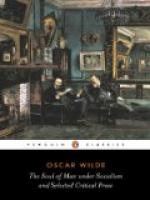In the modern stress of competition and struggle for place, such sympathy is naturally rare, and is also very much stifled by the immoral ideal of uniformity of type and conformity to rule which is so prevalent everywhere, and is perhaps most obnoxious in England.
Sympathy with pain there will, of course, always be. It is one of the first instincts of man. The animals which are individual, the higher animals, that is to say, share it with us. But it must be remembered that while sympathy with joy intensifies the sum of joy in the world, sympathy with pain does not really diminish the amount of pain. It may make man better able to endure evil, but the evil remains. Sympathy with consumption does not cure consumption; that is what Science does. And when Socialism has solved the problem of poverty, and Science solved the problem of disease, the area of the sentimentalists will be lessened, and the sympathy of man will be large, healthy, and spontaneous. Man will have joy in the contemplation of the joyous life of others.
For it is through joy that the Individualism of the future will develop itself. Christ made no attempt to reconstruct society, and consequently the Individualism that he preached to man could be realised only through pain or in solitude. The ideals that we owe to Christ are the ideals of the man who abandons society entirely, or of the man who resists society absolutely. But man is naturally social. Even the Thebaid became peopled at last. And though the cenobite realises his personality, it is often an impoverished personality that he so realises. Upon the other hand, the terrible truth that pain is a mode through which man may realise himself exercises a wonderful fascination over the world. Shallow speakers and shallow thinkers in pulpits and on platforms often talk about the world’s worship of pleasure, and whine against it. But it is rarely in the world’s history that its ideal has been one of joy and beauty. The worship of pain has far more often dominated the world. Mediaevalism, with its saints and martyrs, its love of self-torture, its wild passion for wounding itself, its gashing with knives, and its whipping with rods—Mediaevalism is real Christianity, and the mediaeval Christ is the real Christ. When the Renaissance dawned upon the world, and brought with it the new ideals of the beauty of life and the joy of living, men could not understand Christ. Even Art shows us that. The painters of the Renaissance drew Christ as a little boy playing with another boy in a palace or a garden, or lying back in his mother’s arms, smiling at her, or at a flower, or at a bright bird; or as a noble, stately figure moving nobly through the world; or as a wonderful figure rising in a sort of ecstasy from death to life. Even when they drew him crucified they drew him as a beautiful God on whom evil men had inflicted suffering. But he did not preoccupy them much. What delighted




